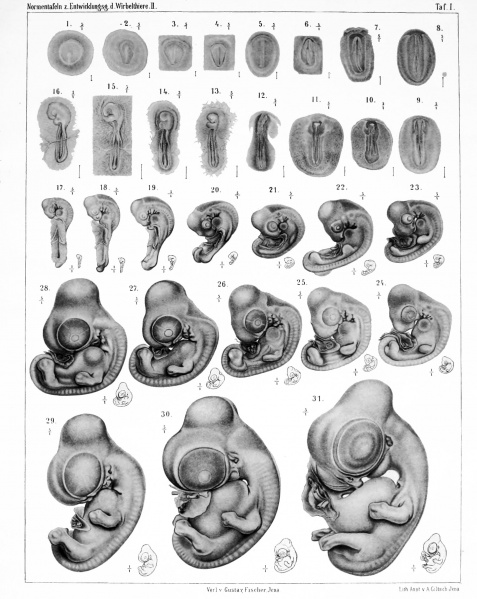File:Keibel1900 plate01.jpg

Original file (1,952 × 2,451 pixels, file size: 519 KB, MIME type: image/jpeg)
Plate 1
Figure legends text shown below is a modified online translation. Original German text.
| Translation Request |
|---|
| The text of this book/article was in German and only the figures and plates may be shown here. Any text translation into English has been by automated Google Translate and may not be an accurate rendition of the original text.
If you would like to help with the online translation into English please contact me. |
Figure 1
(S.N. 452) The germ shown as Figure 1 is taken from a 9 hours incubated egg fixed with sublimate-acetic acid. The whole seed is approximately circular, its diameter is 4.1 mm. The same in the middle is the zona pellucida, which is near the circular shape, but narrows somewhat towards the rear. Its length is 2.3 mm, and its maximum width 2.15 mm. The primitive streak begins about the middle of the zona pellucida with a button-shaped widening and gradually disappears towards the rear end of the zona pellucida, here a considerable width reaching. Its length is 1.2 mm.
The series shows an early stage of mesoderm formation, the mesoderm does not exceed even the scope of the area pellucida. The primitive streak is already embodied in the typical district front than in the rear. A clear head extension does not exist, nor any traces of blood formation.
Figure 2
(S.N. 436) Also the seed shown in Figure 2 was taken from a 9 hours incubated egg fixed with sublimate-acetic acid. The diameter of the whole seed is 4.2 mm. The shape of the area pellucida is pear-shaped, its length is 2.1 mm, its greatest width 1.5 mm. The primitive streak is 1.6 mm long. Before the front end of primitive streak are cells that create the endoderm is tight and the cover the investments of the head extension well. On the primitive streak a distance is far to detect a shallow trough. At the rear end of the primitive streak area is very wide. The mesoderm not go beyond the area of the area pellucida. No traces of blood formation.
Figure 3
(S.N. 455) Of the seed shown in Figure 3 was taken from a 12 hours incubated egg. The blastoderm had a diameter of about 5 mm. The area pellucida was pear-shaped, but very stocky shape. Its length is 2.3 mm , its greatest width 1.85 mm . The length of the primitive streak is about 1.5 mm. The anterior part of the primitive streak is barely visible in the surface image, in contrast, there are very good as it widens towards the rear . The sagittal shows a front verlötheten with the endoderm head extension , which merges without specific delimitation in the lateral mesoderm. At the front end of the area pellucida I see an irregular band in the surface pattern, which thereby comes to appearance that in its domain, the endoderm is considerably thickened . It is Duval 's " croissant anterieur " , the front sickle The mesoderm is not yet even in this seed over the area of the area pellucid addition. No traces of blood formation.
Figure 4
(S.N. 444) The area shown in Figure 4 pellucida was removed from a 12 hour incubated egg and become fixed in sublimate-acetic acid. It shows a very regular shape, its length is 2.1 mm, its greatest width 1.4 mm. The length of the primitive streak is 1.6 mm. The primitive streak carries a rearwardly significant depth primitive groove that suddenly stops at the rear end. Before the area pellucida a front crescent (croissant anterieur) is available. Microscopic examination shows that the head appendage down with • the endoderm in communication and laterally passes into mesodermal cell masses, which also in turn can not be bound, against the endoderm. The mesoderm begins the territory of the area pellucida to pass. From hematopoiesis nothing can be seen.
Figure 5 and 5a
(S.N. 336)
| Historic Disclaimer - information about historic embryology pages |
|---|
| Pages where the terms "Historic" (textbooks, papers, people, recommendations) appear on this site, and sections within pages where this disclaimer appears, indicate that the content and scientific understanding are specific to the time of publication. This means that while some scientific descriptions are still accurate, the terminology and interpretation of the developmental mechanisms reflect the understanding at the time of original publication and those of the preceding periods, these terms, interpretations and recommendations may not reflect our current scientific understanding. (More? Embryology History | Historic Embryology Papers) |
Reference
Franz Keibel, Normentafeln zur Entwicklungsgeschichte der Wirbelthiere (Normal plates of the development of vertebrates) Volume Hft.2 (1900) Jena, G. Fischer, Germany.
Cite this page: Hill, M.A. (2024, June 3) Embryology Keibel1900 plate01.jpg. Retrieved from https://embryology.med.unsw.edu.au/embryology/index.php/File:Keibel1900_plate01.jpg
- © Dr Mark Hill 2024, UNSW Embryology ISBN: 978 0 7334 2609 4 - UNSW CRICOS Provider Code No. 00098G
File history
Click on a date/time to view the file as it appeared at that time.
| Date/Time | Thumbnail | Dimensions | User | Comment | |
|---|---|---|---|---|---|
| current | 23:26, 20 November 2013 |  | 1,952 × 2,451 (519 KB) | Z8600021 (talk | contribs) |
You cannot overwrite this file.
File usage
The following 3 pages use this file:
